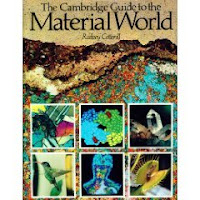 A wonderful book is The Cambridge Guide to the Material World by Rodney Cotterill. A new edition just came out. The images in the book are exquisite. I have found it helpful when preparing lectures on solid state physics. However, I was shocked when I read Cotterill's claim, made in passing, concerning the first observation in 1912 of diffraction of x-rays by a crystal (von Laue, Friedrich, and Knipping):
A wonderful book is The Cambridge Guide to the Material World by Rodney Cotterill. A new edition just came out. The images in the book are exquisite. I have found it helpful when preparing lectures on solid state physics. However, I was shocked when I read Cotterill's claim, made in passing, concerning the first observation in 1912 of diffraction of x-rays by a crystal (von Laue, Friedrich, and Knipping):This experiment ... can be regarded as the most important ever undertaken in the study of condensed matter....Surely not? What about exciting discoveries such as liquefaction of helium, superconductivity, superfluidity in 3He, quasi-crystals, liquid crystals, the universality of critical exponents for the liquid-gas transition, ...?
However, I now tend to agree with this claim.
1. If you don't know the detailed atomic and crystal structure it is hard to explain most properties and start developing theory. Arguably, the central question of condensed matter is ``How do macroscopic properties emerge from microscopic (atomic scale) properties?''.
2. It has become so crucial in other fields beyond condensed matter: mineralogy, chemistry, and structural biology. Practically, everything we know about molecular biology and protein function goes back to structural determinations from x-ray crystallography.




No comments:
Post a Comment